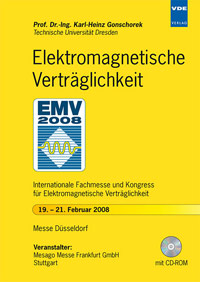Smart Notching – New concepts for EMC coordination
Konferenz: EMV 2008 - Internationale Fachmesse und Kongress für Elektromagnetische Verträglichkeit
19.02.2008 - 21.02.2008 in Düsseldorf, Germany
Tagungsband: EMV 2008
Seiten: 8Sprache: EnglischTyp: PDF
Persönliche VDE-Mitglieder erhalten auf diesen Artikel 10% Rabatt
Autoren:
Schwager, Andreas (Sony Deutschland GmbH, European Technology Center (EuTEC), Stuttgart, Germany)
Hirsch, Holger (Universität Duisburg-Essen, Energietransport und -speicherung, Duisburg, Germany)
Inhalt:
From an EMC point of view a device is compliant if it works in its environment without causing any unwanted interferences. The classical coordination of EMC requires constant emission and immunity limits against high frequency signals. The emission limit of all devices and the own immunity threshold defines the operating range. Devices working within this range run without any interference in their environment. The classical concept to guarantee EMC has the drawback of unused resources. Furthermore devices have costly shielding, even though often there are no disturbing signals. That is all frequencies are shielded by the device independent of where and when the device is operated. In short, resources are not used efficiently. In some cases the reception of a low power signal is disturbed despite the fact that surrounding devices are EMC compliant. From an economical as well as from a technical point of view this is not satisfactory. Here stricter limits should have been chosen. Modern communication systems are able to integrate EMC measures into their design. For example the next generation Powerline Telecommunication (PLT) modems described here, use this approach. Compared to conventional PLT modems which might interfere with short wave (SW) radio services, the modems which use the concept of 'Smart Notching' are less likely to disturb radio receivers. Due to the antenna properties of the low voltage distribution grid, the electricity cables in a building receive signals from radio broadcast services. PLT modems equipped with Smart Notching detect the existence of such radio services by measuring the spectrum of the signals on the mains network. After an analysis of this spectrum the PLT modem excludes frequencies used by radio services. This process is called 'notching'. Thanks to the adaptive OFDM transmission with a high number of carriers, 'smart notching' only causes a minor decrease in the transmission bit-rate because only low SNR carriers are lost. Continuous analysis allows the system to minimize interference and optimize throughput depending on the current conditions. Electromagnetic compliance is achieved in a different way: instead of rigid constraints 'smart notching' devices can comply and improve EMC.


